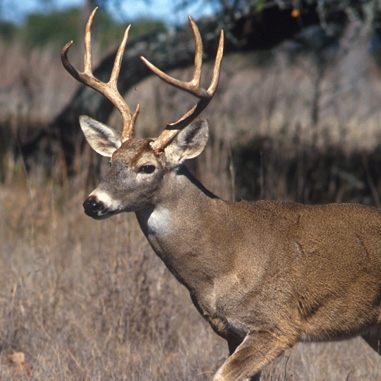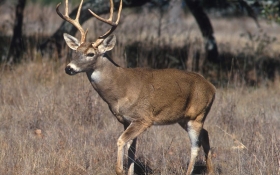
White-Tailed Deer
Odocoileus virginianus
Animal Behavior: Whitetail deer are the most nervous and shy of our deer. They wave their tails characteristically from side to side when they are startled and fleeing. They are extremely agile and may bound at speeds of up to 30 miles per hour through tangled terrain in a forest. Whitetail deer are also good swimmers and often enter large streams and lakes to escape predators or insects or to visit islands. Whitetail deer are generally considered solitary, especially in summer. The basic social unit is a female and her fawns, although does have been observed to graze together in herds of up to hundreds of individuals. Females generally follow their mothers for about two years, but males leave the group within the first year. Whitetail deer are not especially vocal, although young fawns bleat on occasion. Injured deer utter a startlingly loud "blatt" or bawl. Whistles or snorts of disturbed whitetails are the most commonly heard sounds.
Eating Habits: Whitetail deer feed on a variety of vegetation, depending on what is available in their habitat. In eastern forests, buds and twigs of maple, sassafras, poplar, aspen and birch (to name a few) are consumed, as well as many shrubs.
Range: Whitetail deer are able to survive in a variety of terrestrial habitats, from the big woods of northern Maine to the deep saw grass and hammock swamps of Florida. They also inhabit farmlands, brushy areas and such desolate areas of the west such as the cactus and thorn brush deserts of southern Texas and Mexico. Ideal whitetail deer habitat would contain dense thickets (in which to hide and move about) and edges.
Conservation Efforts: Whitetail deer are extremely common throughout their ranges and are the most numerous of the large North American mammals. Precise estimates of their numbers have not been made, but there are probably somewhere between 8 and 15 million on this continent. Although their populations were decimated to the point of extinction in many areas at the turn of the century (due to overhunting), they have recently reached their highest numbers due to the improvement of their habitat by the cutting of climax forests, providing them with a greater amount of brush and shrubs on which to forage.
Animal Facts: Head and body length is 150 to 200 cm, tail length is 10 to 28 cm, and height at the shoulders is between 80 and 100 cm. Odocoileus virginianus dorsal coloration differs in shading locally, seasonally, and among subspecies however, in general it is grayer in the winter and redder in the summer. White fur is located in a band behind the nose, in circles around the eyes, inside the ears, over the chin and throat, on the upper insides of the legs and beneath the tail. Whitetail deer have scent glands between the two parts of the hoof on all four feet, metatarsal glands on the outside of each hind leg, and a larger tarsal gland on the inside of each hind leg at the hock.
